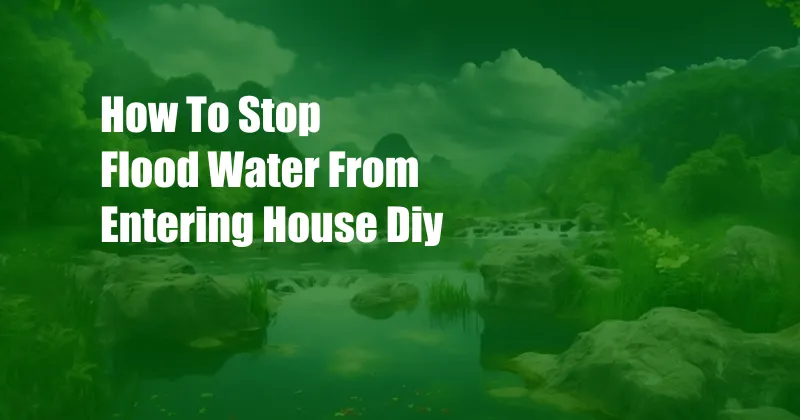
How to Stop Flood Water from Entering Your House: DIY Solutions
Have you ever witnessed the devastation caused by a raging flood, where water relentlessly invades your home, leaving behind a trail of destruction? The thought of such an event is enough to send shivers down anyone’s spine. As floodwaters can rise with alarming speed, it’s crucial to take proactive measures to safeguard your home from potential damage.
In this comprehensive guide, we will delve into various do-it-yourself (DIY) techniques that can effectively prevent flood water from entering your house. We will explore a range of solutions, from simple and affordable methods to more advanced approaches. By carefully implementing these strategies, you can minimize the risk of flood damage and protect your home and belongings.
1. Install Flood Barriers and Seal Entry Points
Flood barriers are designed to create a physical barrier between floodwaters and your home’s entry points. They come in various forms, including sandbags, inflatable dams, and permanent flood walls. Placing sandbags around doors, windows, and other openings can create a sturdy dam to prevent water from seeping into your home. Inflatable dams can be quickly deployed and inflated to form a temporary barrier, ideal for emergencies. Permanent flood walls are a more costly solution but provide long-term protection against floodwaters.
In addition to installing flood barriers, it’s essential to seal any potential entry points where water can infiltrate your home. Inspect your property for cracks or gaps in walls, foundations, and pipes. Use caulk, expanding foam, or weatherstripping to seal these openings and prevent water from leaking in.
2. Elevate Essential Items and Appliances
If floodwaters threaten to inundate your home, elevate essential items and appliances to higher levels. Move furniture, electronics, and valuables to upper floors or place them on raised platforms. You can also use watertight containers to protect important documents, photos, and heirlooms from water damage.
For appliances such as refrigerators, dishwashers, and washing machines, consider placing concrete blocks or bricks underneath them to elevate them off the ground. This simple step can prevent water from damaging the electrical components and motors of these appliances.
3. Create a Flood Diverting System
If your property is prone to flooding, consider creating a flood diverting system to redirect water away from your home. Dig a trench around the perimeter of your house and line it with a perforated pipe. Cover the trench with gravel or soil to create a drainage system that collects and redirects floodwaters away from your foundation.
Alternatively, you can install a sump pump in your basement or crawlspace. A sump pump is a submersible pump that automatically pumps water out of your home when it reaches a certain level. This can prevent basement flooding and protect your belongings from water damage.
4. Plant Water-Absorbing Vegetation
Incorporating water-absorbing vegetation around your home can help reduce the amount of runoff and potential flooding. Plants such as rain gardens, bioswales, and wetlands are designed to absorb and retain rainwater, preventing it from overflowing into your yard.
By planting trees and shrubs with extensive root systems, you can create a natural barrier that helps hold soil in place and prevents erosion. This, in turn, reduces the risk of soil saturation and flooding.
5. Regularly Clean Gutters and Downspouts
Clogged gutters and downspouts can contribute to flooding by preventing rainwater from draining properly. Ensure that your gutters and downspouts are free of leaves, debris, and other obstructions. Clean them regularly, especially before heavy rainfall, to ensure water can flow freely away from your home.
Consider installing gutter guards to prevent leaves and other debris from accumulating in your gutters. This simple step can save you time and effort in the long run and reduce the risk of flooding.
Expert Advice for Flood Prevention
In addition to the DIY solutions mentioned above, here are some expert tips and advice to help you prevent flood damage to your home:
• **Obtain flood insurance:** Flood insurance is crucial for protecting your home and belongings from financial losses due to flooding. Review different insurance policies and choose one that meets your specific needs and budget.
• **Create an emergency plan:** Develop a comprehensive emergency plan that outlines what to do before, during, and after a flood. Include evacuation routes, contact information for emergency services, and a list of essential items to take with you.
FAQs on Flood Prevention
Q: What is the most effective way to prevent floodwater from entering my house?
A: The most effective way to prevent floodwater from entering your house is to create a comprehensive plan that involves installing flood barriers, sealing entry points, elevating essential items, and implementing flood diverting systems.
Q: What are some simple and affordable flood prevention measures I can take?
A: Simple and affordable flood prevention measures include cleaning gutters and downspouts, planting water-absorbing vegetation, and sealing cracks or gaps around entry points.
Q: How can I prepare for a flood if I live in a high-risk area?
A: If you live in a high-risk flood area, it’s essential to obtain flood insurance, create an emergency plan, and consider installing permanent flood protection measures such as flood walls or sump pumps.
Conclusion
Flooding can be a devastating event, but by taking proactive steps to prevent water from entering your home, you can minimize the risk of damage and protect your family and belongings. Implement the DIY solutions discussed in this guide, follow expert advice, and stay informed about flood risks in your area. By working together, we can create a safer and more flood-resilient community for all.
Are you interested in learning more about flood prevention and preparedness? Share your thoughts and questions in the comments section below.